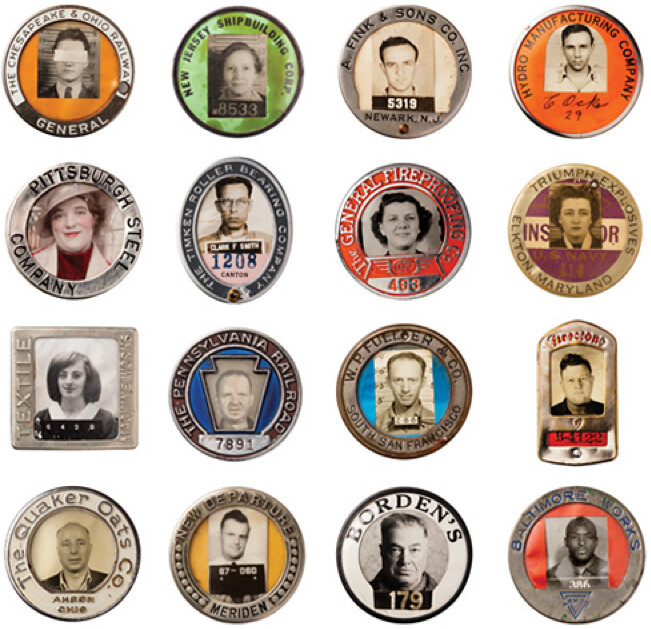
I have a new obsession, and it's very PermaRec-ish. It's going to take a while to tell the whole story, so please settle in and bear with me.
It all started in January, when my friend Jack told me about a cool-sounding exhibit at the Ricco Maresca Gallery in Manhattan. The exhibit featured 250 vintage employee photo I.D. badges, primarily from the 1930s, ’40s, and ’50s. These were badges that many companies used to require their workers to wear for identification purposes, just as many employees nowadays have to wear laminated I.D. cards around their necks.
Vintage photo badges had never been on my radar before, but I immediately saw their appeal. For starters, they're beautiful little objects. They're also a great source of vernacular photography and portraiture. The tiny I.D. head shots offer a rich cast of faces offering a full range of humor, pathos, menace, and more, just like the head shots on the Manhattan Trade School report cards that gave birth to the Permanent Record project.
Also, the badges capture and evoke a very industrial, manufacturing-y sense of America's bygone production economy. Part of this is because many of the badges were used by industrial companies, but it's also because the badges themselves feel like industrially produced objects — a very satisfying parallel that you can see in, for example, these two badges:
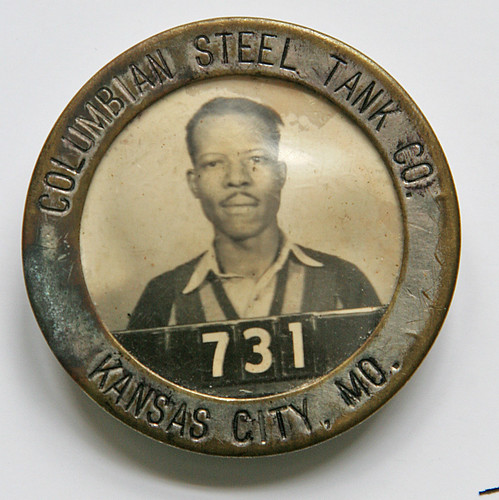
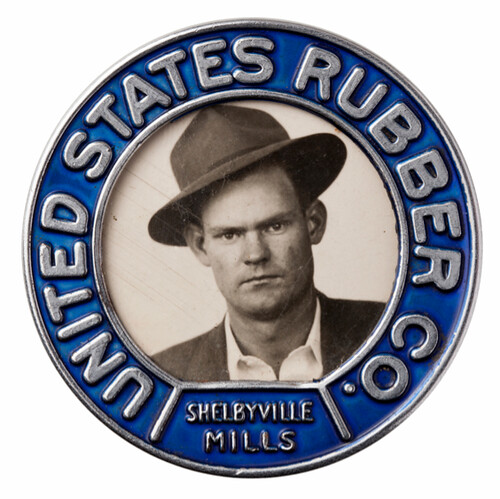
The badges also reflect certain realities about the American workforce of generations past: The overwhelming majority of the photos show employees who were white and male. This isn't surprising, but it's still interesting to see.
Best of all, though, the badges represent a mother lode of stories waiting to be told. Who were these people? How did they come to be working for these companies? Were the photographers professional studio cameramen, or were they just "the guy who takes the head shots" at each company? What happened to the companies (most of which are now defunct)? Were there certain manufacturers that specialized in making the badges? And how did the badges become available on the collectibles market — like, did the employees keep them when they retired and then the badges became available at estate sales when the employees died, or did the companies keep the badges and then the badges found their way to vintage dealers after the companies went belly-up?
It took about two weeks until I was free to go check out the exhibit. But during those two weeks I became increasingly obsessed with photo I.D. badges. As I quickly discovered, there's a brisk market for them on eBay, where they can usually be found by searching on "employee photo badge" and "worker photo badge." Perfect, I thought — I'll buy a few of them and start a little collection. Unfortunately, as I also discovered, they tend to sell for at least $50, and often for considerably more than that. That was more than I was willing to spend, especially for such small items. (I mentioned this to my friend Robin Edgerton, who's very knowledgeable about various collecting subcultures. "You used to be able to get them for around $10 each," she told me, "but they went through a collector's frenzy the last few years and have gotten pricey." Dang.)
But if I couldn't afford to collect the photo badges, I could at least collect photographs of them. So I spent a few days downloading over 100 badge photos from assorted eBay auctions, just so I could look at them, study them, obsess over them. Here's the gallery I ended up with (if the slideshow below doesn't work for you, or if you'd rather see the photos as a gallery instead of a slideshow, click here):
As I looked at more and more of the badges, one thing that occurred to me (and is probably occurring to you) was that many of the employee photos looked like police mug shots. More specifically, they reminded me of the photos in Least Wanted, Mark Michaelson's amazing 2009 book of vintage police mug shots. It had been a while since I'd poked around Michaelson's Flickr page, where he posts his latest mug shot acquisitions, so I went there and discovered, to my surprise, that he has a set of employee badge photos. As I clicked through them, I saw that in 2010 another Flickr user had asked Michaelson, "Where on earth do you find them all?," to which Michaelson had responded, "I've been getting them from eBay from time to time for years now. I think I have a couple hundred." Well, at least I was on target when I saw the commonality between the mug shots and the badges, but I also started realizing that I was very late to this party.
Meanwhile, I still hadn't gone to see the gallery exhibit. I finally did so in mid-February, just before it was taken down (it's now gone, so you can't go see it yourself — sorry). After having spent a few weeks poring over photos of the badges, it was exciting to finally see the real things. They were mounted on a single row of pegs that stretched along the gallery walls (first photo by me, the other two by Ricco Maresca Gallery; click all three images to enlarge):

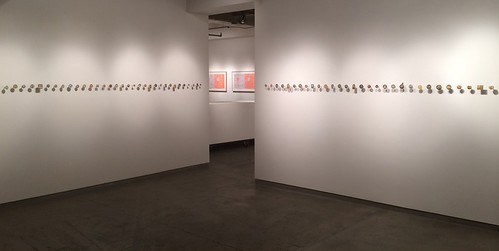

Most of the badges were about two inches across — a bit larger than I had assumed (it was hard to gauge their size from the eBay photos, most of which had nothing to provide any sense of scale). Seeing hundreds of them lined up one after the other was mesmerizing. So many gorgeous badge designs, so many fascinating faces.
There was very little information about how the badges had been collected or arranged, but I had read that they were all from the collection of one of the gallery's owners, Frank Maresca. As I walked through the exhibit, I noticed someone sitting at a computer in an office off to the side of the gallery space, so I stuck my head in and, on a hunch, asked the guy if he happened to be Frank Maresca. He was.
I explained that I was a journalist interested in the stories behind found objects and asked if he had a few minutes to talk about the badges. He graciously agreed. I didn't record our conversation or take notes, but I've reconstructed as much of our chat as I can remember. All of this recollected dialogue should be considered paraphrasing, not direct quotation:
Permanent Record: How long have you been collecting the badges?Frank Maresca: About five years. I started collecting them with the specific goal of creating this exhibit.
PR: Did you get most of them on eBay?
FM: A few of them came from eBay, but for the most part I put the word out to vernacular photography dealers, who were able to procure a lot of them for me.
PR: Why did you collect the badges from this particular period (i.e., the 1930s, ’40s, and ’50s)?
FM: It was an incredibly eventful 30-year period — maybe the most eventful 30-year period we'll ever see, what with the Great Depression, World War II, and the rise of the postwar middle class.
PR: Have you tried to research the stories behind any of the employees shown on the badges?
FM: Several people have asked me about that. No, I haven't done anything like that. But I'm going to be doing a small book about the badges, and that kind of research might be a good to include. Maybe I'll put a few interns on that. I assume it would take a fair amount of time, though.
PR: I really like the way you arranged the badges in a single row instead of, say, in a rectangular grid.
FM: Thanks. I laid them out in a very specific sequence. As I'm sure you could see, they form a narrative, almost like frames in a movie.
PR [totally bullshitting]: Yeah, I picked up that.
In fact, I didn't discern any kind of narrative in the badge sequence. After I spoke with Maresca, I went back out in the exhibit room and looked at the badges again — still no narrative or pattern, at least that I could see. Maybe I was too dense to see what he was up to, or maybe he was up to something so esoteric that it only made sense to him. Either way, I was happy to enjoy the badges as a random collection of extremely evocative objects.
But while I wasn't able to find any narratives in Maresca's badge sequence, I'm assuming there are lots of narratives to be found within the individual badges themselves. Most of the badges just show the company's name, a head shot, and an employee I.D. number. But some of them — maybe 25% or so — also include the employee's name. I've gathered a bunch of these name-inclusive badges (some culled from eBay listings, others from the Maresca exhibit) and gathered them into their own photo set.
Once you look at the name-inclusive badges, a few interesting things become apparent. For example, it appears that at least three members of the Stump family worked for the Goshen Rubber & Manufacturing Company (click to enlarge):
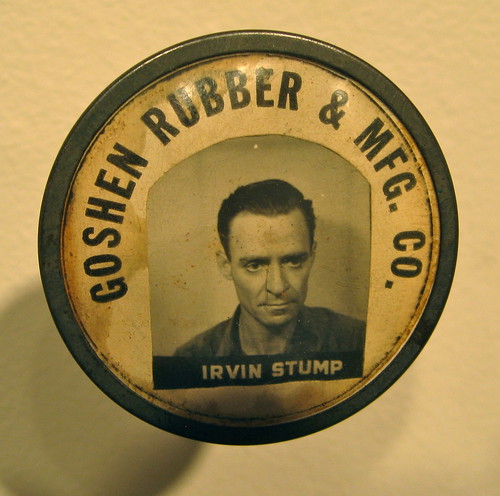

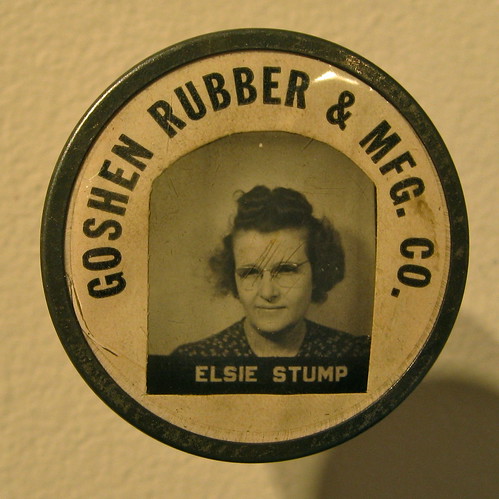
I was curious about this, so I didn't some quick Googling and learned that Goshen Rubber & Manufacturing was located in Goshen, Indiana. In 1999 it was acquired by Wynn's International, which in turn was acquired the following year by the Parker Hannifin Corporation, a New Jersey engineering company. I made a phone call to Parker Hannifin and confirmed that the Goshen plant still operates today under Parker's ownership.
I didn't know exactly when Irvin, Alice, and Elise Stump's badges were from, or how old the three Stumps were when those badges were made, but it seemed obvious that all three of them were now retired and probably deceased. I'm no whiz at this kind of research, and I don't currently have an active Ancestry.com membership (always helpful for this kind of thing), but here's what I found with some basic Googling:
• An Irvin Stump, residing in Goshen, was listed in the 1940 census. He died in 1964, and his obituary specifically mentioned that he worked at the Goshen Rubber Company.
• An Alice Stump, residing in Goshen, was listed in the 1940 census. I was not able to find an obituary for her, but the census lists her year of birth as 1910, which means she would now be 103 or 104 years old. She's likely deceased.
• An Elsie Stump, residing in Goshen, was listed in the 1940 census. She died in 1982.
• Elsie Stump's 1940 census entry notes that her household included a Lloyd Stump — presumably her husband. A Lloyd Stump was also listed in Irvin Stump's obituary as one of Irvin's surviving brothers, and there was another surviving brother named George Stump. Although we don't have employee badges for Lloyd or George, it appears that they worked at Goshen Rubber too, because they're mentioned in the text of the decision from a 1940 lawsuit brought by the National Labor Relations Board against Goshen Rubber. Here are the two pertinent passages:
"On May 12 there appeared in the [Goshen Rubber & Mfg. Co.] plant a petition, prepared by foreman Harold Kintigh, stating opposition to any labor organization 'other than that which might be organized solely among the employees.' It was signed by 40 production employees and 6 foremen. Lloyd Stump (foreman of the trimming department) took it into the trimming room and told the employees therein that 'they could all read it and use their own judgment about signing it,' adding that he 'believed the office might approve of it.'""George Stump testified that Hoffman had told him that 'he believed someone caught him smoking.' There was evidence that other workmen had been discharged for smoking."
We've already seen Lloyd listed alongside Elsie in the 1940 census, which said he was born in 1899. He appears to have died in 1978. As for George, he too was listed in the 1940 census, with a birth year of 1897. I was unable to find a death notice for him, but he would now be at least 116, so I think it's safe to say he's deceased.
In short, Goshen Rubber & Manufacturing employed a whole lot of Stumps. As it turns out, the Stumps appear to have been one of the area's pioneer families, which presumably explains why there are so many Stumps currently living in Goshen. (In fact, according to this PDF from two months ago, the current president of the Goshen Redevelopment Commission is Thomas Stump.) So just about any Goshen employer is likely to have its share of Stumps. (Update: Reader Bill Maselunas, who has an Ancestry.com account, did a little Stump family research. And reader Scott Jackson came up with a page from the 1946 Goshen city directory that shows how many Stumps were listed back then. Interestingly, the addresses for several of them are rubber companies!)
That's just the tip of the narrative iceberg that emerged from about two hours' worth of Googling regarding a few randomly chosen badges. I'm sure there's plenty more to learn about the Stumps and about Goshen Rubber, and a whole lot more to learn about the employees and employers shown on the other badges.
I hope to delve into this a bit more, time permitting. If anyone else would like to do some research, please get in touch and we can assign specific badges to specific people. I'm pretty sure there's some good stuff waiting to be discovered here.
(Special thanks to my pal Jack Kirr, who let me know about the gallery exhibit and therefore got this whole ball rolling. See what you've started, Jack?)

Very cool. There really is a ton of character in each one of these little items. Thanks for putting this together.
ReplyDeleteGreat account Paul! I'm one of those Uni-Watch devotees who also follow you here. I know the amount of effort this takes, with little to no material return. I appreciate the effort. Provide updates when you can!
ReplyDeleteThanks so much for the kind words, Keith -- greatly appreciated.
DeleteDitto. Permanent Record is even more fascinating than UniWatch. Love them both. Thanks Paul.
ReplyDeleteGreat story. I do have to go back and re-read it but I was taken with the Pennsylvania Railroad badge. Now I am asking through a couple of Yahoo groups if other railroads used that type of ID. Specifically the New Haven RR, Southern Pacific RR and the Santa Fe Railway.
ReplyDeleteThis comment has been removed by the author.
ReplyDeleteNot only the post of magnetic badges but all the post that you have written in this blog are informative.
ReplyDeletemagnetic badges & staff badges
Saw a small collection of these 20-24 in the Metropolitan Museum in New York last December 2019 , not sure if they have a bigger collection in starage
ReplyDelete